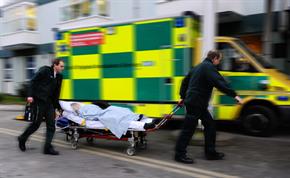
Although the Trust does not train any member of staff to restrain, you may find yourself in a situation where a patient is being restrained manually or mechanically by others.
The risk of death from either asphyxia or in patients with underlying medical conditions, either during or following a restraint, is very high. It is important for us to be aware and monitor the patient’s vital signs.
Under NICE guidelines, there are a range of factors that should be considered to minimise the risk of harm to patients who have been restrained.
Vital signs of the patient should be obtained upon arrival as usual. If you are unable to, it’s important to make a note of the time and reason. You should challenge whether the level of restraint is still necessary and make a note of the response.
Special considerations (crew challenge) should be taken to adhere to NICE recommendations around restraint:
You should continue to assess, monitor and treat a patient who is being restrained, whilst ensuring that they are:
An early response to any deterioration in vital signs is very critical.
NHS England have released a patient safety alert on the importance of vital signs during and after restrictive intervention. Please click here for the full alert and further guidance.
Published 21st January, 2016